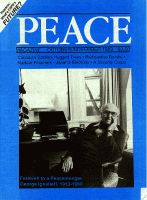
Peace Magazine Oct-Nov 1989, page 14. Some rights reserved.
Search for other articles by Martin Zellig here
I FIRST MET SAM DAY at a Hiroshima-Nagasaki Weekend of Action in 1986. A stubby, gravelly voiced "older" peacenik with thick lensed glasses perched on a bulbous nose, Sam shared with us his impressive knowledge of U.S. nuclear weapons policy. The former editor of the Bulletin of Atomic Scientists, Sam was now active with Nukewatch, a group that exposed to public scrutiny the 1000 missile silos in the Midwest and Great Plains, and the dangerous transportation of nuclear warheads. Members of Nukewatch have also engaged in non-violent civil disobedience.
This year Sam Day has been a prisoner of conscience. In 1988 peace activists entered 10 Missouri launch sites simultaneously. By disturbing sensor beams above the silo lids, they were briefly able to force the Air Force to shut these missile sites down. Nukewatchers Sam Day and Bonnie Lee Urfer were sentenced to prison.
I have been corresponding with Sam during his stay in Prison. His letters reveal an undaunted spkit. Here are some examples.
Lafayette County Jail, Lexington, Mo.
Dear Martin,
The day before yesterday the judge in Kansas City sentenced me to the maximum six months, as expected. This means I'll be moved soon to a federal prison.... I brought a copy of Nuclear Heartland into jail. The inmates were shocked by the number of red spots on the map of Missouri. The other prisoners are much younger than me. Many are here for drug related offenses. We play a lot of cards in the evening. Mornings and afternoons are work hours for me -- reading and writing. I'm getting a lot of support from local activists and feeling connected with the missile silo organizing work.
Lafayette County Jail April 20, 1989
Dear Friends & loved ones,
[This is the statement I read to the judge at my sentence hearing in U.S. District Court in Kansas City:]
The property that I trespassed last August 15 is no ordinary plot of land. Buried beneath it is an intercontinental ballistic missile armed with a nuclear warhead one hundred times more powerfi£l than the bomb that destroyed Hiroshima. It is aimed at people on the other side ofthe Earth. Within the Western Judicial District ... there are 150 such launch sites. Together they contain enough deadly force to kill hundreds of millions of people.
As Phillip Berrigan has said, law is the immaculate guardian of the nuclear terrorism waged by our Government. I entered Site K8 in the full knowledge that the law upholds the Government's right to be free of interference while preparing to blow up the world. But! also know that such laws are subject to judicial review. It was my intention to give a court the opportunity to strip away legal protection from nuclear genocide in the same way courts in earlier times have struck down slavery, racial segregation and similar practices once accepted but now repugnant to civilized people.
This is not the first chapter in the story of nonviolent resistance to laws sanctioning nuclear annihilation. Nor will it be the last. Just as I have been moved by the examples of others, so will I hope and believe that I will serve as an example to others. Together, and in all humility, we hope to give you and your colleagues in the Western District of Missouri many opportunities to reconsider your responsibilites as judges and as citizens.
Sam Day suffered a slight stroke in May but his health is good. After the stroke he was ignominiously transferred from the Leavensworth Federal Prison to the Yankton County Jail, South Dakota, a minimum security prison with such amenities as a library, tennis courts, gymnasium, pool tables, laundry rooms and TV rooms. Despite his being assigned a choice job in the prison, Sam refused to work for the system that "imprisons me for refusing to cooperate with the larger system of nuclear annihilation." Sam writes:
"The Yankton Federal Prison Camp lost no time expelling me. Within two hours I was mustered out and on my way to the Yankton City Jail, where I now find myself in the more comfortable setting of iron bars, an iron bunk, and the ever-murmuring, inescapable T.V. seL It's a prison that looks and sounds and acts and feels like a prison -- the proper place for a antinuclear activist to be. I feel great once again."
Martin Zeilig is an activist with WCCD in Winnipeg.

Peace Magazine Oct-Nov 1989, page 14. Some rights reserved.
Search for other articles by Martin Zellig here